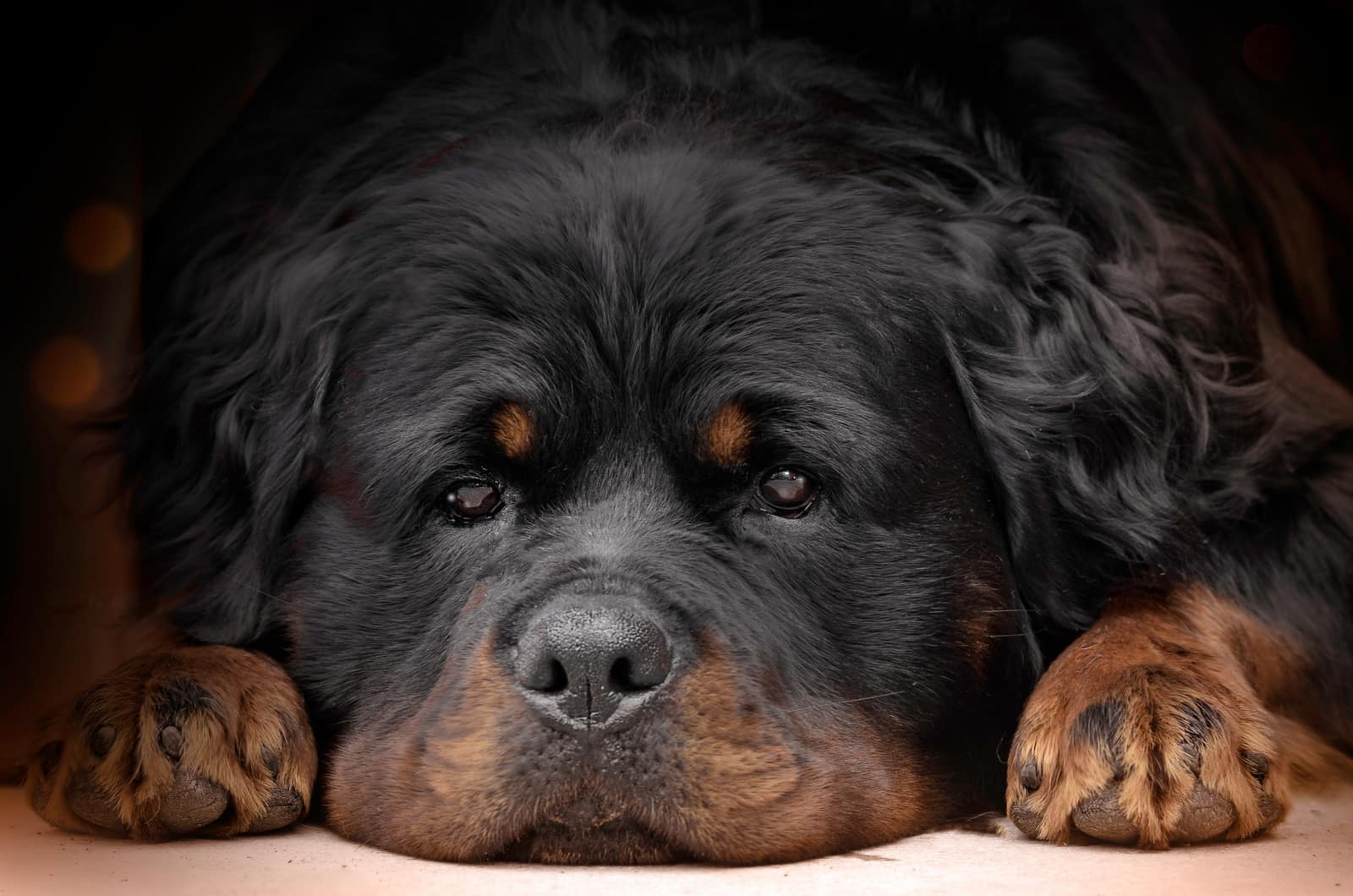Yes, you read that right – there is such a thing as a Long-Haired Rottweiler!
When we think of this proud, powerful dog, we imagine it with a short, sleek, glossy black and tan coat. That’s just how Rottweilers are, isn’t it? We may have seen Rottie puppies that tend to be on the fluffy side, but this soon grows out as they develop. So, what’s all this about some of them having long hair?
Well, although it’s rare, it is possible for Rottweilers to have long coats!
If you’re intrigued by this, or perhaps thinking of getting one of these unusual dogs, then take a moment to read through our guide to discover more.
Long-Haired Rottweilers: The Facts

Photo from:@wigglebuttmags
First, it’s all down to genetics. A litter of Rottweiler puppies can sometimes have one, maybe two pups with a long coat, even if both parents have short coats. However, two long-coated Rotties might produce a litter that’s a mix of long and short coats, or no long coats at all!
The second reason for Long-Haired Rottweilers being so rare (especially in America) is because long hair is regarded as a serious fault according to the breed standards laid down by organizations such as the American Kennel Club (AKC). This means that they are disqualified from shows as they don’t conform to the required standards.
But, that’s not the shocking bit. Because of the strict breed standards, some Rottweiler breeders will actively avoid producing or selling long-haired dogs, which makes them rarer still. It is a known fact that many will go as far as euthanizing healthy pups simply because they have a long coat.
Does that sound like an ethical thing to do?
Any reputable breeder with an ounce of compassion will sell the pups rather than destroy them, usually with the understanding that they are ‘pet quality’, which is definitely a more acceptable and less controversial policy than taking a life because it doesn’t conform to a narrow set of rules.
Finally, many people don’t accept that the Long-Haired Rottweiler is a pure breed. They see what looks like a Rott, but with a long, wavy coat, and they assume that it is a mixed breed.
In a few cases, they may be right. But, it is a fact that purebred Long-Haired Rottweilers exist, and they are every bit as beautiful as their short-haired siblings.
Long-Haired Rottweiler Puppies
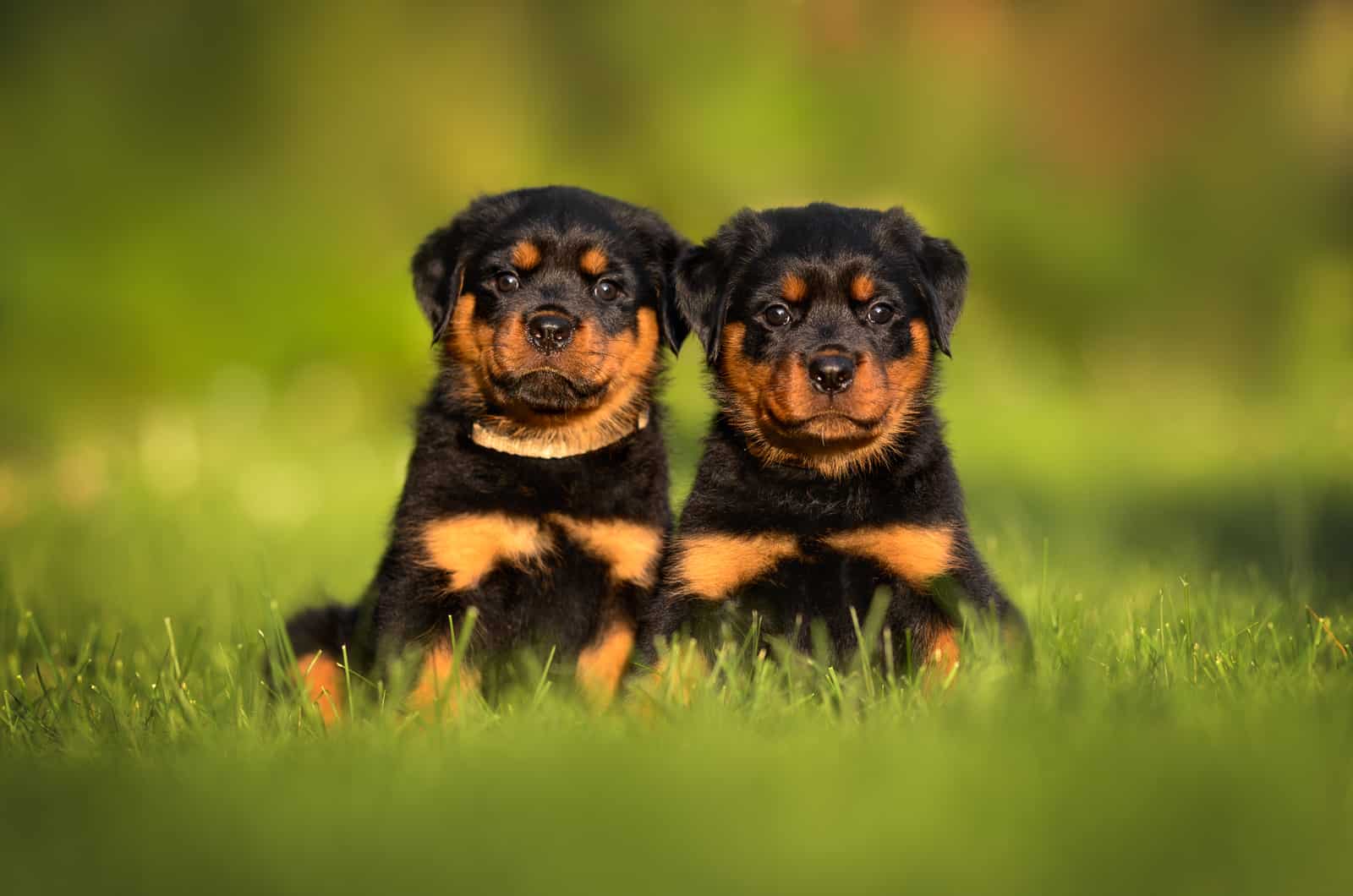
Finding one of these little beauties might be a challenge! They might be rare, but the demand for them is high, so you could be in for a long wait.
Before you go searching for a breeder, do some homework on the breed. It might seem obvious, but that tiny pup will grow into a large dog pretty quickly. Are you ready to cope with this? Will your home stand up to the rigors of having a big dog bouncing around? Do you have the space for it? Have you considered how this will affect your finances? Are you familiar with the characteristics of this breed? Are you a first-time dog owner?
Owning a pet of any kind is a big responsibility. They will be dependent on you for everything, especially in the first few months. You’ll need to set aside time for grooming, obedience training, potty training, exercise, and plenty of cuddles.
Rottweilers might seem big and menacing, but they are people-oriented dogs that just love human company. Your pup will continue to follow you around even when he’s all grown up. He’ll watch your face, reading the subtle changes in expression, and waiting for a kind word or command. He won’t enjoy being left alone, particularly as a pup (which is never a good thing to do anyway), and you will probably find that he’ll trash your home just to spite you!
Long-Haired Rottweiler puppies are extremely adorable, but you should be 100% certain about getting one before you go ahead.
Long-Haired Rottweiler Grooming
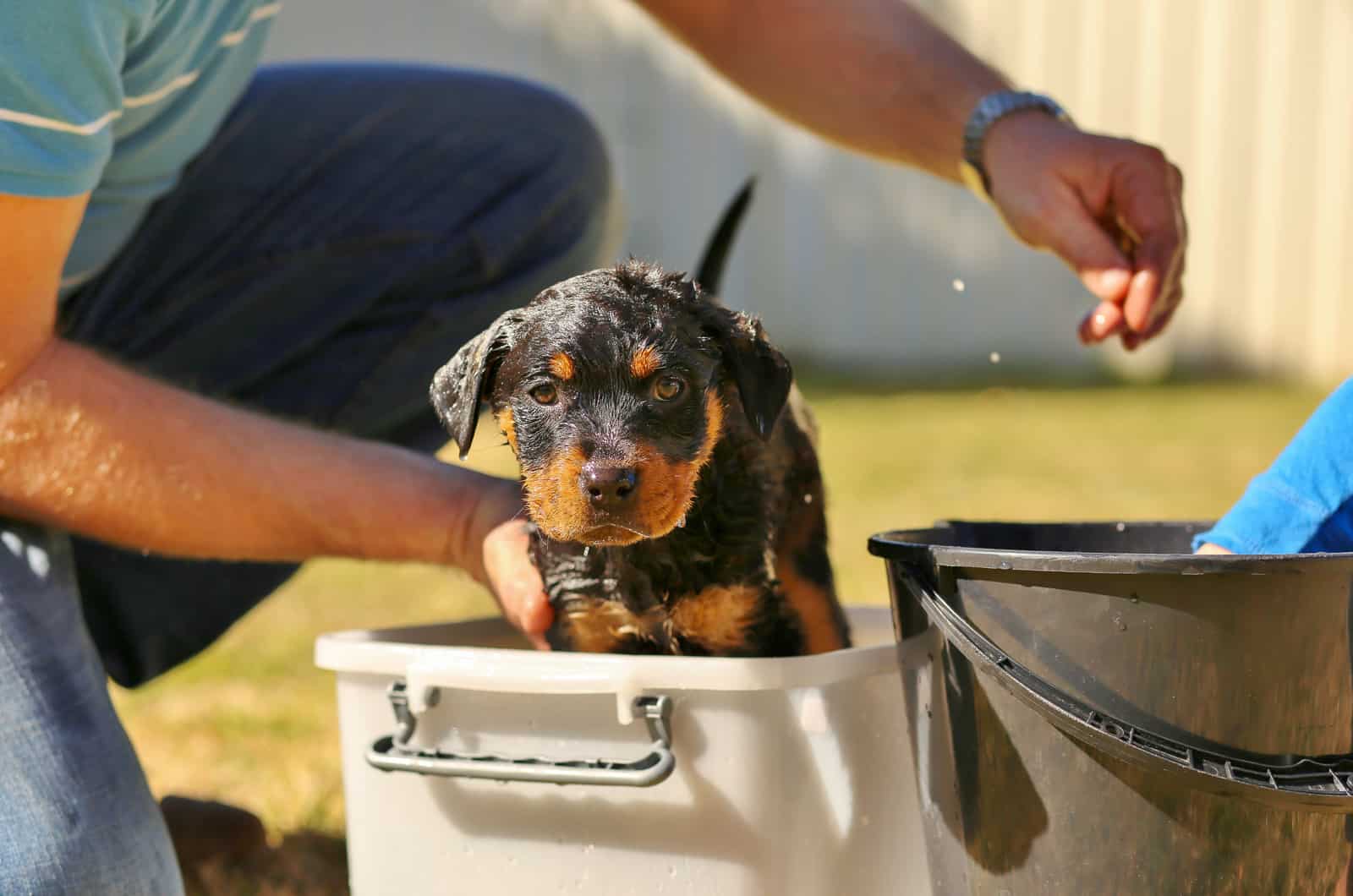
All dogs require some level of grooming to keep their coat healthy and clean. Dogs with longer coats usually need a bit of extra care.
The Long-Haired Rottweiler should ideally be brushed every day to remove tangles and matting. This will also help to keep them free of fleas and ticks that they pick up from outdoors.
Though daily brushing might seem a bit of a chore, it should only take a few minutes of your day. Your dog will appreciate it, and you’ll enjoy the close bond that this encourages between you.
Also, regular brushing cuts down the amount of hair that sticks to your furniture and clothes as your dog sheds. Rotts are moderate shedders, although the long-haired dog will seem to shed more because there’s more hair to shed! Seasonal shedding (or molting) happens twice a year in spring and fall when the dog’s undercoat blows. You’ll know when this happens as there will be an excessive amount of hair coming off on the brush!
As well as brushing, you can reduce hair loss by feeding your dog a healthy, balanced diet that’s rich in protein and omega 3 and 6 fatty acids. These nutrients keep the hair follicles healthy, meaning that they hang onto the hairs longer. They also help the dog produce natural oils that make the coat glossy, protecting it from the elements.
Bathing is an important part of the grooming regime, but you shouldn’t bathe your Long-Haired Rottweiler more than once a month as it can strip away those natural oils and dry out their skin. Always try to use a breed-specific shampoo and conditioner, and never be tempted to use those formulated for humans!
Of course, if your pooch decides that it’s fun to roll in the mud (or worse!), then you’ll need to give it a bath, but on the whole, once every four or five weeks is adequate.
Can You Shave A Rottweiler?
Well, if you have one with a short coat, you wouldn’t need to.
But, if we’re talking about a Long-Haired Rottweiler, then the answer is NO! A dog’s coat, whatever its length, helps them to regulate their body heat. Shaving their fur will mess up their ability to do this. Many people consider shaving their dogs in the summertime to help them cope with the heat. This isn’t necessary as the dog will adapt well to the conditions as long as you allow them a shady place to escape from the sun and provide plenty of fresh, cool water.
And, in all probability, it will grow back unevenly, looking patchy and weird.
Considering that Long-Haired Rottweilers are rare, it would be a shame to get one and then remove the very thing that makes it so different.
Do Long-Haired Rottweilers Have Health Problems?
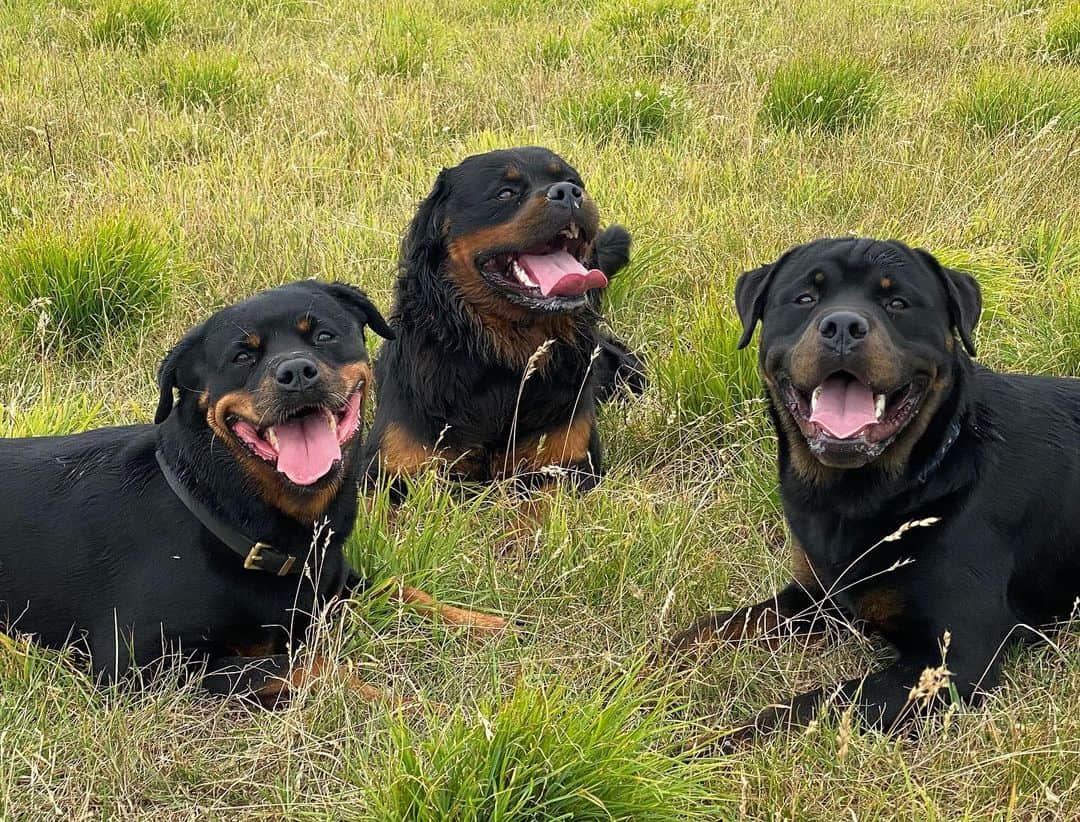
Photo from: @marley_and_kody_the_rotties
No more so than the short-haired version!
There are many myths surrounding dog genetics, and a lot of people are taken in by misinformation about health problems associated with coat color and the long-hair gene.
Read Next: Are Red Rottweilers A Red Flag For Rottweiler Lovers?
The fact is, there is not one shred of credible evidence to suggest that Long-Haired Rotties are more prone to sickness and diseases of any kind.
That doesn’t mean that they avoid illness altogether as they can still succumb to any of the common health issues that other Rottweilers can suffer from.
Here are a few to watch out for:
• Hip dysplasia – a malformed hip joint that causes bones to grind together. This can lead to arthritis when older, and surgery is often used to treat severe cases.
• Elbow dysplasia – similar to the above, but in the elbow joint.
• Aortic stenosis – a heart disease that narrows the aorta, restricting oxygen-rich blood from reaching the rest of the body. This can cause lethargy, breathing difficulties, fainting, and in severe cases, heart failure.
• Entropion – the eyelid turns inward causing the eyelashes to rub against the cornea. This is painful and can cause ulcers and infections.
• Cruciate ligament rupture – cruciate ligaments are so called as they form a cross shape in the knee joint, helping the dog to move its leg. These can become torn or ruptured completely. Treatment depends on the severity of the condition, and it ranges from rest, physiotherapy and anti-inflammatories, to surgery in order to repair the damage.
To reduce the chances of your dog having any of these, you should seek an established, reputable breeder who runs a proper health screening program.
Long-Haired German Rottweiler
However, you’ll find three types of Rotties mentioned: German, Roman, and American. Each one is virtually the same, but with subtle differences in shape, build, and temperament.
The names can be misleading as they don’t necessarily indicate where the dog is from or where it was bred.
Here’s a very quick guide to the three:
• German Rottweiler – these have a muscular build and a blocky head achieved through excellent breeding programs. Many are actually imported from Germany as the breeding standards are high, and the ADRK stipulates that they must be placid, good-natured, and fond of children. Although some are originally from Germany, subsequent generations of pups from these dogs can be said to be German Rottweilers as they inherit the same genes.
• Roman Rottweiler – not actually from Rome! There’s really no such thing as a Roman Rottweiler, and this is an attempt by some breeders to produce a bigger dog, way beyond accepted breed standards. The thinking behind this seems to be that ‘bigger means better’, but this is not the case. In fact, being over-sized can lead to health complications. It could be said that this is a cynical way of trying to get more money out of dog lovers who prefer large breeds.
• American Rottweiler – again, it could be said that there isn’t any such thing as an American Rottweiler! However, those that are described are longer in the legs and have smaller heads. The reason why there are noticeable differences in the American or German dogs is because of poor-quality breeding in the U.S. Over the years, the AKC has allowed some breeders to register and sell pups as purebred, even though the parents are clearly faulty in some way. Puppy mills and backyard breeders add to the problem by producing poor-quality dogs.
So, there really is only one type of Rottweiler, and although the breed’s roots are in Germany, they shouldn’t be distinguished by country. It might be a good idea to copy Germany’s example and ensure that all of these wonderful dogs are equally healthy and of good temperament.
Oddly enough, the recessive gene that causes long hair in these dogs is more commonly found in the German Rottweiler. As these are the source of all Rotties, then it could be argued that it’s a natural part of the breed and should not be discouraged.
How Much Does A Long-Haired Rottweiler Cost?
If you can find one of the few good breeders who sell Long-Haired Rottweilers, then you should expect to pay between $1,500 and $2,500, which is roughly the same as you’d pay for a short-haired version.
You may find that some breeders will charge more, playing on the fact that these dogs are rare. If so, you might want to find your Long-Haired Rotty elsewhere as a breeder who capitalizes on features like this probably isn’t of the best character.
After all, if having a long coat is a serious fault, then why should you pay extra? If anything, you should pay less!
How Much Does A Rottweiler Puppy Cost?
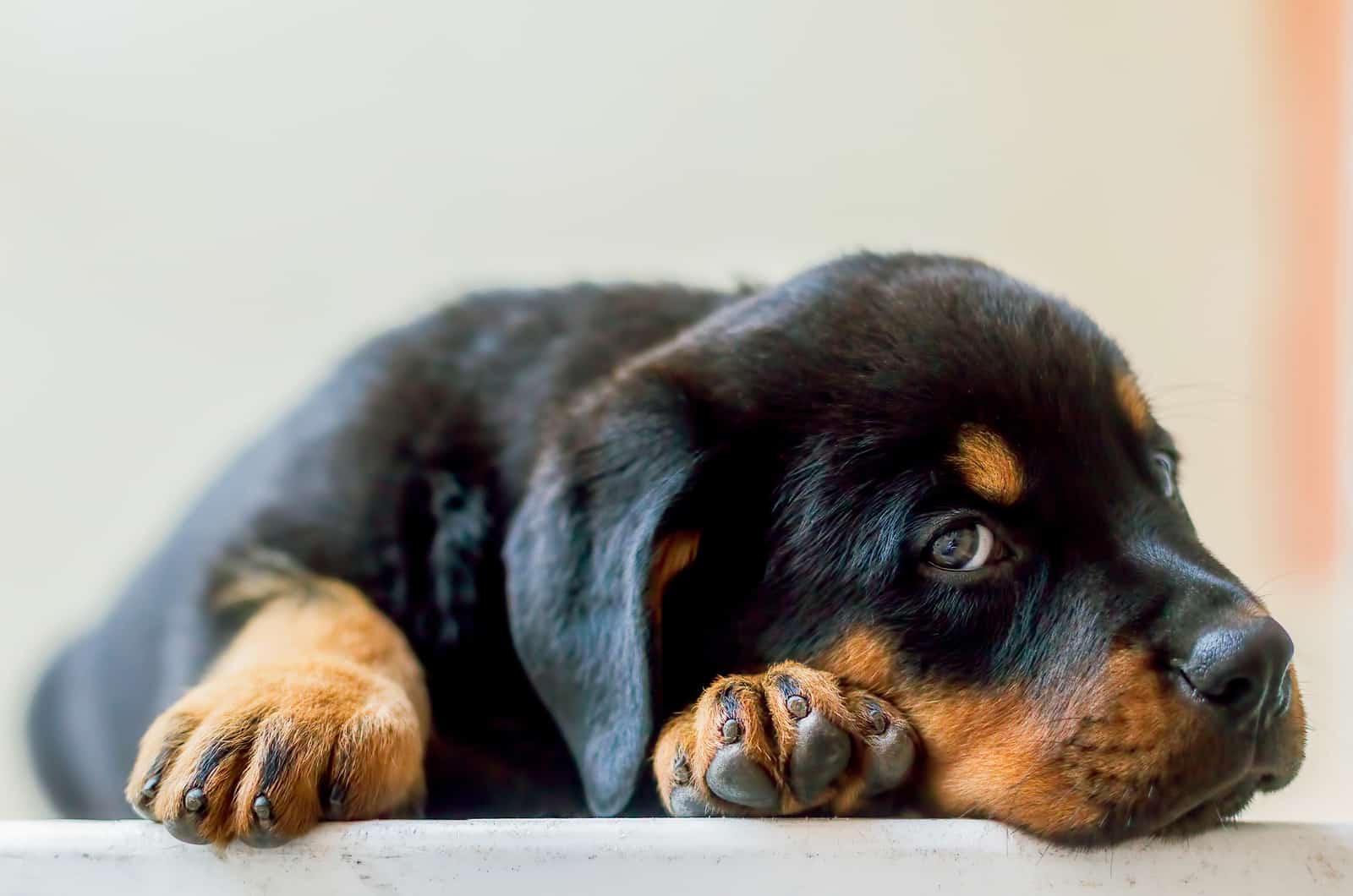
Just like many other dog breeds, the cost of a Rottweiler puppy can vary greatly. You can find them for sale starting from around $850 and going as high as $5,000, maybe more.
So, why is there such a wide gap?
Much will depend on the breeder’s reputation and how long they’ve been established. Their knowledge and experience allows them to charge more as their dogs will most likely be of higher quality. For the breeders themselves, this is both a positive and a negative thing. The more effort they put into their breeding program; the more costs they incur. They seek out champion sires to improve the bloodline, but this will cost them much more. They’ll also import breeding dogs from other breeders overseas, incurring yet more costs. And, that’s before we mention extensive health testing!
If $5,000 seems a little steep, you can find breeders who sell ‘pet quality’ Rottweiler pups. They will still be healthy, and some will still qualify for conformation and agility shows. More importantly, they’ll make excellent family pets.
Although it’s understandable that you want to save money, be very wary of anyone selling Rottweiler puppies too cheaply. $850 is probably the lowest you should go without asking why the dog is being sold for so little. In fact, at that price, you can be fairly sure that the seller is a puppy mill!
As a general rule, you should expect to pay around $1,500 for a healthy, pet quality Rottie pup. This might vary according to your location and local demand, and you might pay more for a female. The main thing is to do your homework, and avoid any seller you don’t trust!
Long-Haired Rottweiler With Tails?
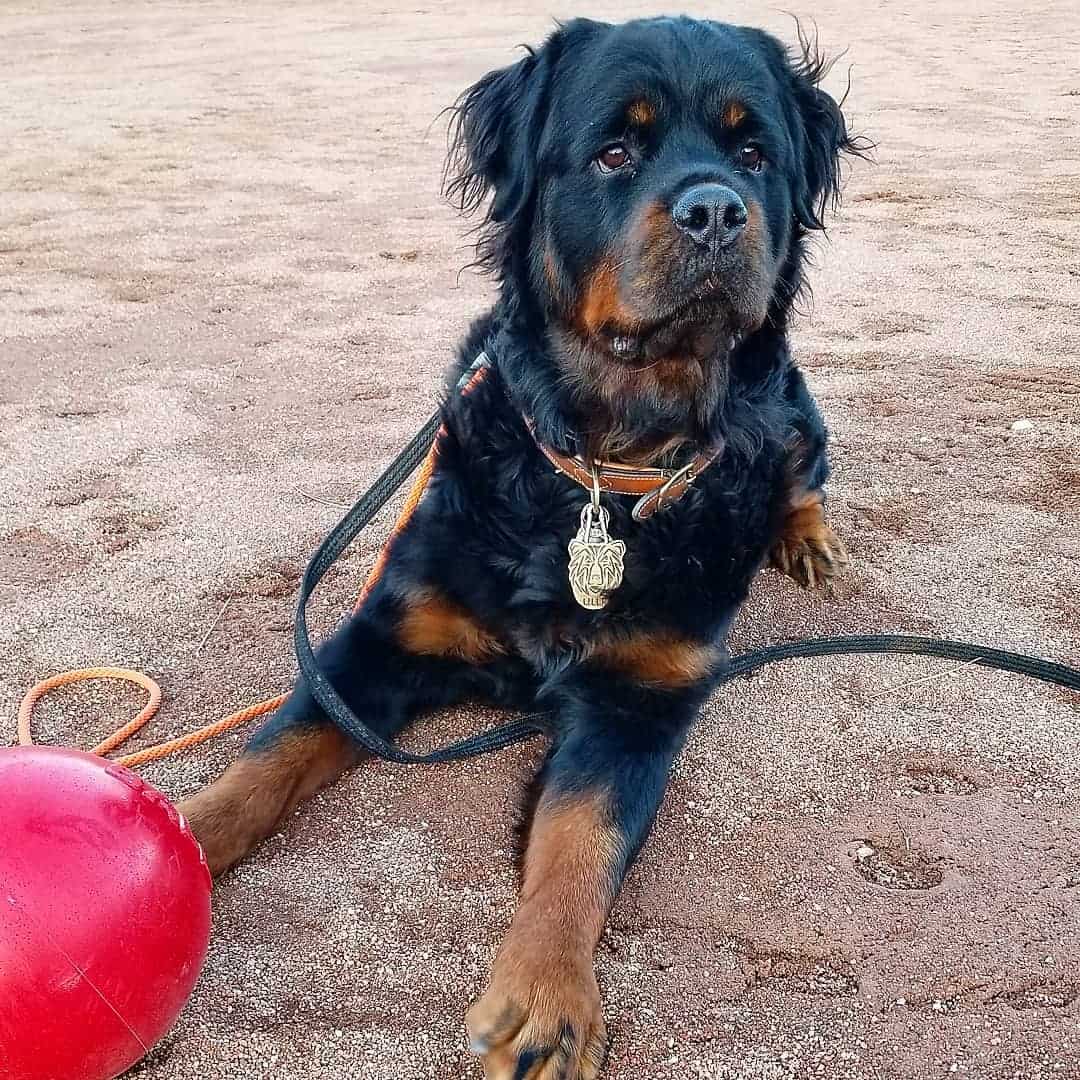
Photo from: @lifewithozrottweilers
Here, we have another controversial topic! Do Rottweilers even have tails?
The simple answer is, yes, Rottweilers do have long tails. That is, they naturally have tails just like any other dog breed whether they are long- or short-coated.
In the past, tails were docked, which means they were cut off or a band was tightly tied around the base of the tail until it dropped off. This was done to avoid the tail getting in the way as most of these were working dogs used for pulling carts, herding livestock, or hunting.
Some were also fighting dogs, and a tail was a weak point that an opponent could grab hold of, causing a lot of pain and damage. Tails were inconvenient, and so they were disposed of.
Today, the majority of dogs are kept as companions and family pets. Even though we still have working dogs these days, they are not exposed to the same dangers and hazards, which negates the need for tail docking in the majority of cases.
Large breeds, like Rottweilers, are often used as guard dogs, and some people argue that if they have tails, then an intruder could grab it and use it as a means of defeating or getting past the dog somehow. You only have to read that sentence a couple of times to see how ridiculous it sounds. First, can you imagine someone managing to get to a Rottweiler’s back end when the dog is in attack mode? Second, other guard dogs, such as the German Shepherd, manage pretty well with a tail!
Basically, tail docking is an outdated, cruel, and unnecessary procedure. It is performed for purely cosmetic reasons simply to satisfy AKC standards, and it has no practical function whatsoever.
Need more convincing?
Recent studies have proved that puppies feel pain more acutely than adult dogs. In the past, those in favor of docking claimed that the earlier you perform the procedure, the better as pups didn’t feel it. In truth, as the neural pathways are not fully formed and insulated, the pain pathways from the nerve centers to the brain are shorter and more direct.
This means that pups feel pain far more acutely than adult dogs.
It’s one thing if a tail is docked under some kind of anesthesia, which is usually no more than a basic cream applied to the affected area, but many people – including breeders – aren’t prepared to pay for each pup to be seen properly. This means that corners are cut and the procedure is performed cheaply, resulting in further agony for the pups.
We could continue this debate for many pages, listing all the benefits of dogs keeping their tails. However, we’ll end it here by saying that in Germany, the home of the Rottweiler breed, the ADRK (Allgemeiner Deutscher Rottweiler Klub) has changed its breed standards to state that all Rotts should have natural tails. Tail docking is banned in many countries around the world. Perhaps it’s time for everyone else to catch up.
Long-Haired Rottweiler Temperament
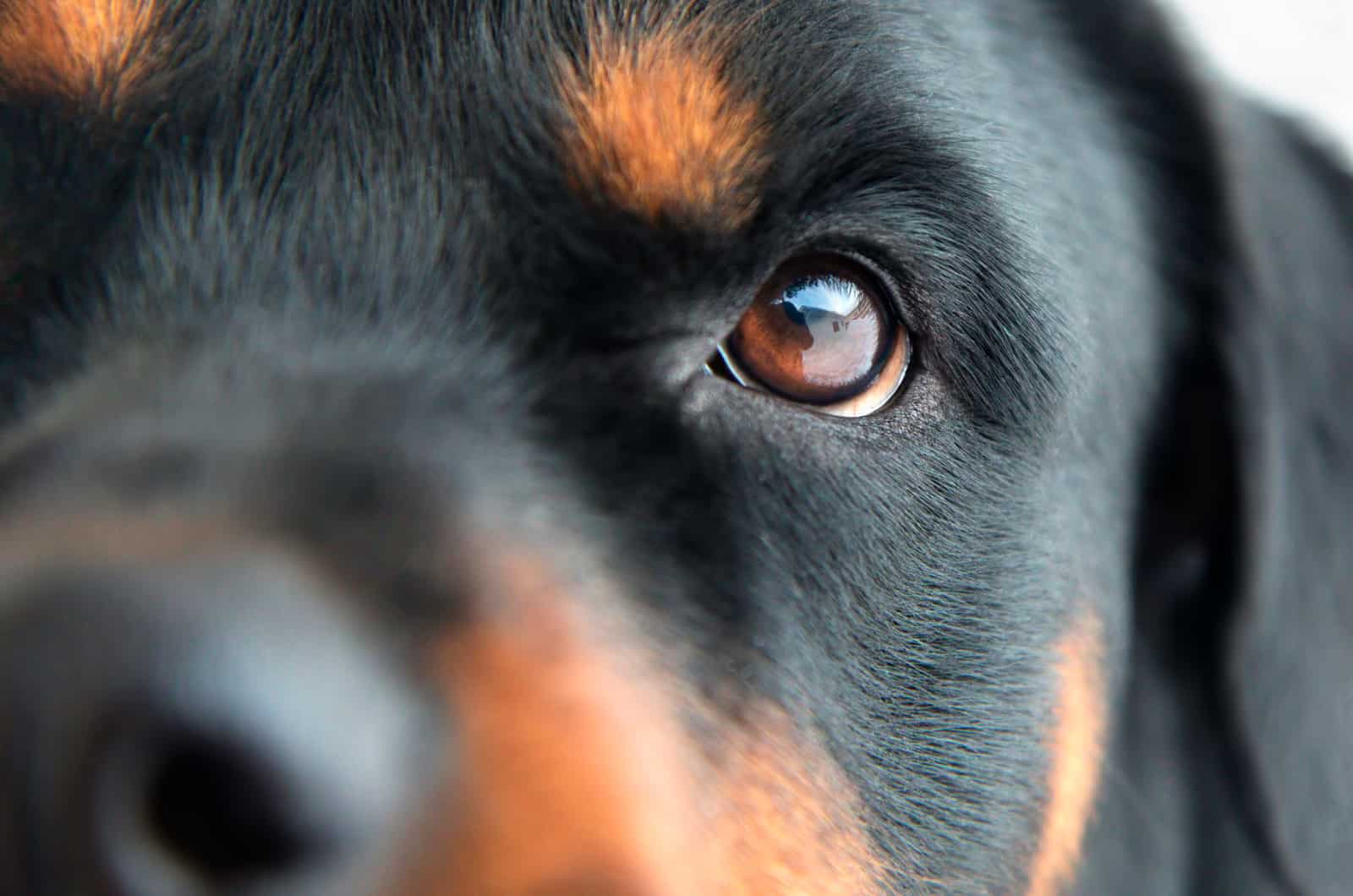
Just as with their health concerns, there is no evidence to support the notion that Long-Haired Rottweilers are any different from their short-haired counterparts.
To those who are unfamiliar with the breed, the Rotty can be intimidating. And, in all honesty, they are. At least, they are big, powerful dogs with the potential to cause a lot of damage if they’re not properly handled and cared for!
Does this mean that they are unsuitable as a family dog? Far from it! The faithful Rott (enthusiasts have many names for them!) is an excellent family pet. They are devoted, affectionate, loving, and safe to have around kids. They can be protective, which is what makes them such great guard dogs.
Sadly, like so many other breeds, horror stories about attacks and fatalities abound. Yes, the Rottweiler, long coat or short, can be aggressive at times. But, so can most other breeds. Aggression is difficult to identify as it has so many causes, and the dogs themselves can’t tell you what the problem is.
Fear, pain, and disease can play a part. Abused animals may develop an aggressive streak as a means of defense.
All good breeders strive to reduce aggression and bring out the best qualities in their dogs. Back yard breeders, puppy mills, and hobby breeders will not have such an ethical outlook, leading to poor breeding standards, which is often why we still have aggressive dogs today.
Once again, it comes down to choosing a reputable breeder and being a responsible dog owner. Obedience training and socialization at a young age are imperative.
Each dog has its own personality and character, and the best way to iron out any stubbornness and bad behavior is through firm, consistent training, and by introducing your pup to as many other dogs, people, animals, and experiences as you can while they are still young.
Final Thoughts
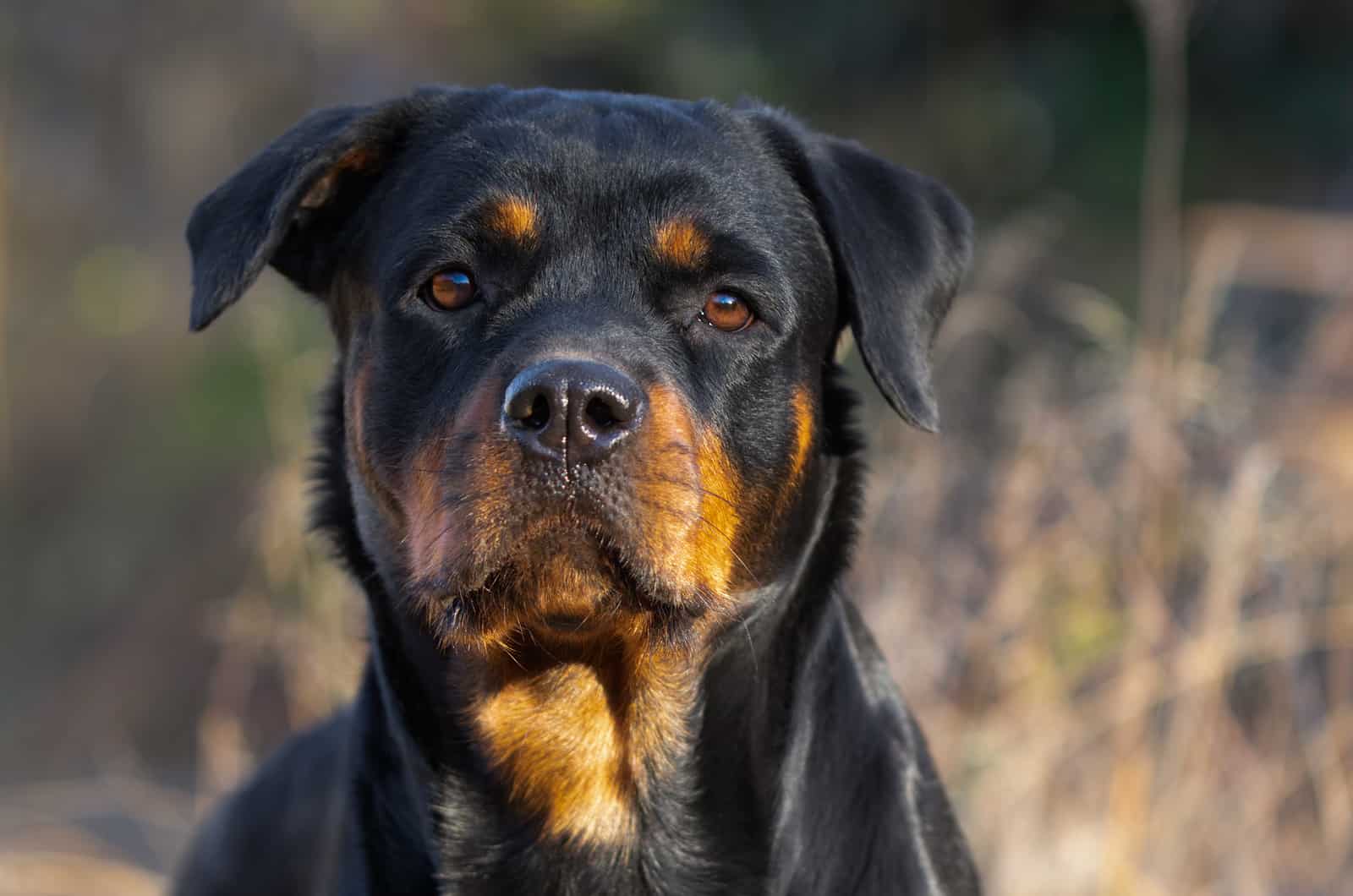
So, what does the future hold for the Long-Haired Rottweiler?
Professional breeders may feel conflicted about producing them. Few will do so on purpose – at least until the breed standards are changed to accept them.
Nothing can take away from the fact that these are beautiful dogs. They are just as healthy as their short-coated counterparts, they share a similar temperament, and the only thing that sets them apart is their long, wavy coat.
To most dog lovers who are just looking for a best friend, the fact that they don’t qualify for the show ring is neither here nor there. Who cares if it has longer hair? It’s just as loveable, and it makes just as good of a pet, companion, or guard dog.
The fact that these adorable dogs are in high demand bodes well for their future. Also, for a while now, there has been a tangible shift in attitudes towards animal welfare around the globe. This is evident from the ban on tail docking we mentioned above as well as in many other areas. Old, cruel, outdated methods and attitudes are being replaced by compassion and understanding.
This means that we could soon see a change in breed standards that embrace these furry giants. Even if that isn’t the case, reputable breeders could still choose to produce top-quality, purebred Long-Haired Rotties, still with their tails intact, as they should be.
The Long-Haired Rottweiler might be rare right now, but in time to come, you could start to see more of them around. And, that can only be a good thing!
